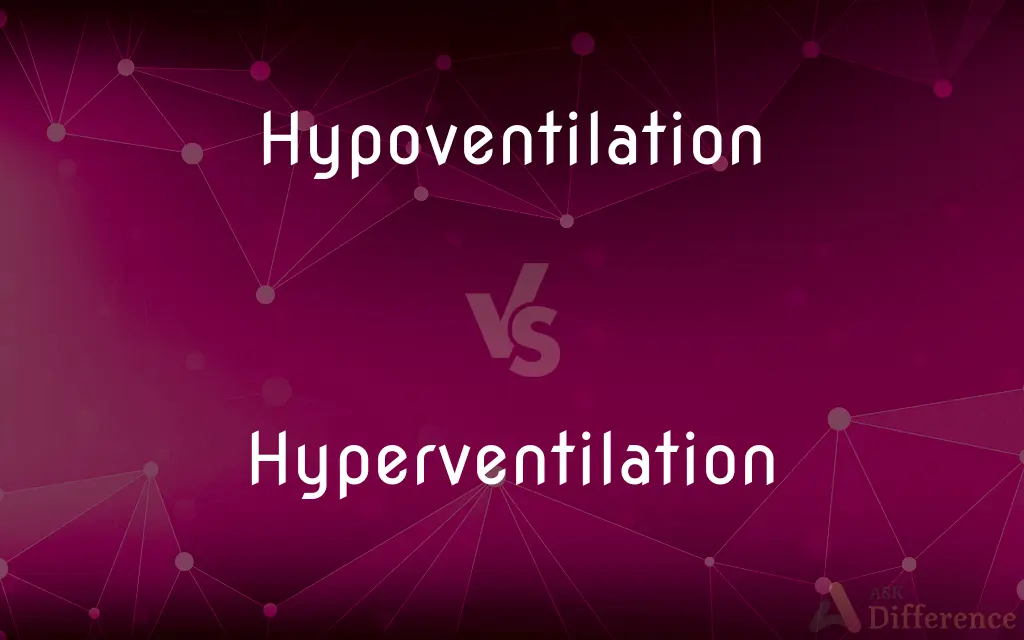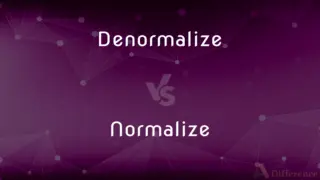Hypoventilation vs. Hyperventilation — What's the Difference?
By Urooj Arif & Fiza Rafique — Updated on March 13, 2024
Hypoventilation is under breathing, leading to increased carbon dioxide, while hyperventilation is overbreathing, reducing carbon dioxide levels.

Difference Between Hypoventilation and Hyperventilation
Table of Contents
ADVERTISEMENT
Key Differences
Hypoventilation occurs when ventilation is inadequate to perform proper gas exchange in the lungs, leading to an increase in carbon dioxide (CO2) levels in the blood. This condition can result from shallow or slow breathing and is often associated with disorders that impair respiratory function, such as chronic obstructive pulmonary disease (COPD) or neuromuscular diseases. Hyperventilation, in contrast, involves breathing at an abnormally rapid rate or depth, leading to excessive expulsion of carbon dioxide from the body. This can occur as a result of anxiety, panic attacks, or certain medical conditions that stimulate the respiratory center in the brain.
The key difference between the two conditions lies in the CO2 levels and their physiological effects. Hypoventilation leads to an accumulation of CO2, causing the blood to become more acidic, while hyperventilation reduces CO2 levels, increasing blood pH (alkalosis). Both conditions disrupt the body's acid-base balance and can have significant health implications if not addressed.
Management of hypoventilation often focuses on treating the underlying cause and may involve supplemental oxygen or mechanical ventilation in severe cases. Hyperventilation management usually aims to address the cause, such as anxiety or pain, and techniques to control breathing rate, like breathing into a paper bag, can be effective in acute episodes.
Despite their differences, both hypoventilation and hyperventilation highlight the importance of maintaining proper breathing patterns and the delicate balance of gases in the blood, crucial for optimal body function.
Comparison Chart
Definition
Inadequate ventilation leading to increased CO2 levels.
Excessive ventilation causing decreased CO2 levels.
ADVERTISEMENT
Causes
Respiratory disorders, obesity, sedatives.
Anxiety, panic, pain, respiratory stimulants.
Symptoms
Headaches, dizziness, fatigue, confusion.
Lightheadedness, tingling, palpitations, spasms.
Blood Gas Changes
Hypercapnia (increased CO2), respiratory acidosis.
Hypocapnia (decreased CO2), respiratory alkalosis.
Management
Treat underlying cause, oxygen therapy, ventilation.
Address cause, controlled breathing, reassurance.
Compare with Definitions
Hypoventilation
Insufficient breathing leading to inadequate gas exchange.
Hypoventilation in sleep apnea can significantly disrupt sleep quality and overall health.
Hyperventilation
Breathing more rapidly or deeply than necessary, reducing CO2.
During the panic attack, she experienced hyperventilation, which made her feel lightheaded.
Hypoventilation
A condition marked by an increase in blood CO2 levels.
The patient's hypoventilation was evident from his elevated arterial CO2 levels.
Hyperventilation
Results in respiratory alkalosis due to decreased CO2 levels.
The lab tests confirmed respiratory alkalosis, a clear sign of hyperventilation.
Hypoventilation
Managed through addressing the underlying cause and supportive measures.
Managing his hypoventilation involved using a CPAP machine at night.
Hyperventilation
Managed by calming the individual and controlling breathing.
To manage her hyperventilation, she used breathing exercises to slow her breath rate.
Hypoventilation
Can result in symptoms related to CO2 buildup.
She felt drowsy and confused, symptoms indicative of hypoventilation.
Hyperventilation
Can lead to a range of physiological symptoms due to low CO2.
His hyperventilation caused numbness in his hands and feet, a common symptom of the condition.
Hypoventilation
Often associated with respiratory system impairments.
Chronic obstructive pulmonary disease can lead to hypoventilation due to decreased lung function.
Hyperventilation
Often triggered by psychological factors like stress or fear.
Stressful situations frequently trigger hyperventilation in individuals with anxiety disorders.
Hypoventilation
Hypoventilation (also known as respiratory depression) occurs when ventilation is inadequate (hypo meaning "below") to perform needed respiratory gas exchange. By definition it causes an increased concentration of carbon dioxide (hypercapnia) and respiratory acidosis.
Hyperventilation
Hyperventilation occurs when the rate or tidal volume of breathing eliminates more carbon dioxide than the body can produce. This leads to hypocapnia, a reduced concentration of carbon dioxide dissolved in the blood.
Hypoventilation
Reduced or deficient ventilation of the lungs, resulting in reduced aeration of blood in the lungs and an increased level of carbon dioxide in the blood.
Hyperventilation
Abnormally fast or deep respiration, which results in the loss of carbon dioxide from the blood, thereby causing a fall in blood pressure, tingling of the extremities, and sometimes fainting.
Hypoventilation
(medicine) Respiratory depression, occurring when ventilation is inadequate to perform the necessary gas exchange, which may be caused by certain medical conditions, by holding one's breath, or by drug overdose.
Hyperventilation
(medicine) the state of breathing faster or deeper than necessary
Hyperventilation
The act or process of hyperventilating; breathing rapidly and deeply.
Hyperventilation
A condition in which alveolar carbon dioxide concentration is markedly lower than normal, usually due to breathing rapidly and deeply.
Hyperventilation
An increased depth and rate of breathing greater than demanded by the body needs; can cause dizziness and tingling of the fingers and toes and chest pain if continued
Common Curiosities
What are the symptoms of hyperventilation?
Symptoms include lightheadedness, tingling in the limbs, shortness of breath, and in severe cases, muscle spasms.
Can hyperventilation be dangerous?
Yes, if prolonged, it can lead to significant electrolyte imbalances and impair oxygen delivery to the brain, potentially causing fainting or seizures.
What causes hypoventilation?
Hypoventilation is often caused by conditions that impair lung function, such as COPD, or by anything that inhibits normal breathing, like obesity or certain medications.
Can lifestyle changes help with hypoventilation?
Yes, weight loss, avoiding sedatives, and treating underlying lung conditions can help improve breathing patterns in people with hypoventilation.
How can one prevent hypoventilation?
Addressing and managing conditions that impair breathing, maintaining healthy weight, and avoiding medications that depress the respiratory system can help.
Is hypoventilation the same as respiratory failure?
Hypoventilation can lead to respiratory failure if severe and untreated, as it results in inadequate oxygenation and removal of CO2.
How is hypoventilation diagnosed?
It can be diagnosed through blood gas analysis, showing elevated CO2 levels, and by identifying the underlying conditions contributing to reduced ventilation.
What immediate steps should be taken for someone hyperventilating?
Encourage slow, controlled breathing, use of a paper bag to rebreathe CO2 in acute cases, and seek to calm the individual if anxiety is a factor.
Are there long-term effects of hyperventilation?
Chronic hyperventilation can contribute to anxiety disorders, disrupt blood pH balance, and cause persistent symptoms like dizziness and tingling.
What role does anxiety play in hyperventilation?
Anxiety and panic attacks are common triggers of hyperventilation, as the body's fight-or-flight response can lead to rapid, shallow breathing.
Share Your Discovery

Previous Comparison
Hexose vs. Monosaccharide
Next Comparison
Denormalize vs. NormalizeAuthor Spotlight
Written by
Urooj ArifUrooj is a skilled content writer at Ask Difference, known for her exceptional ability to simplify complex topics into engaging and informative content. With a passion for research and a flair for clear, concise writing, she consistently delivers articles that resonate with our diverse audience.
Co-written by
Fiza RafiqueFiza Rafique is a skilled content writer at AskDifference.com, where she meticulously refines and enhances written pieces. Drawing from her vast editorial expertise, Fiza ensures clarity, accuracy, and precision in every article. Passionate about language, she continually seeks to elevate the quality of content for readers worldwide.














































